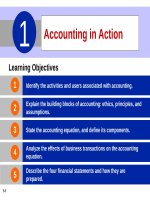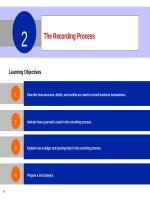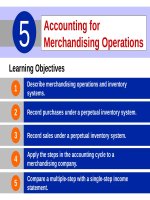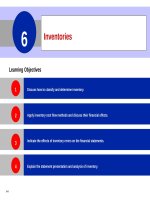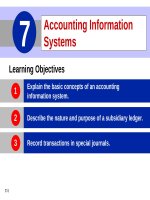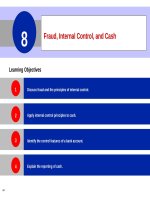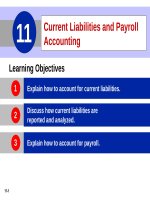Accounting principles 12th willey kieso chapter 07
Bạn đang xem bản rút gọn của tài liệu. Xem và tải ngay bản đầy đủ của tài liệu tại đây (2.66 MB, 46 trang )
7
Accounting Information
Systems
Learning Objectives
7-1
1
Explain the basic concepts of an accounting
information system.
2
Describe the nature and purpose of a subsidiary ledger.
3
Record transactions in special journals.
LEARNING
OBJECTIVE
1
Explain the basic concepts of an
accounting information system.
Accounting information system (AIS) collects and
processes transaction data and communicates financial
information to decision makers.
Includes:
All
steps in the accounting cycle.
Documents
Manual
7-2
that provide evidence of transactions.
or computerized accounting system.
LO 1
Basic Concepts of AIS
Cost Effectiveness - Benefits
must outweigh the costs.
Illustration 7-1
Principles of an efficient
and effective accounting
information system.
Useful
Output
Flexibility - The system should
be sufficiently flexible to meet
the resulting changes in the
demands made upon it.
7-3
LO 1
Computerized Accounting Systems
Software
programs (functions include sales,
purchases, receivables, payables, cash receipts
and disbursements, and payroll).
Generate
financial statements.
Advantages:
►Typically
7-4
enter data only once.
►Many
human errors are eliminated.
►More
timely information.
LO 1
Computerized Accounting Systems
CHOOSING A SOFTWARE
ENTRY-LEVEL
PACKAGE
SOFTWARE
►Easy
data access and report preparation
►Audit
trail
►Internal
control
►Customization
►Network
Compatibility
ENTERPRISE
RESOURCE
PLANNING SYSTEMS
7-5
LO 1
Ethics Insight
Curbing Fraudulent Activity with Software
The Sarbanes-Oxley Act (SOX) requires that companies demonstrate that they have
adequate controls in place to detect significant fraudulent behavior by employees. The
SOX requirements have created a huge market for software that can monitor and trace
every recorded transaction and adjusting entry. This enables companies to pinpoint who
used the accounting system and when they used it. These systems also require
“electronic signatures” by employees for all significant transactions. Such signatures verify
that employees have followed all required procedures, and that all actions are properly
authorized. One firm that specializes in compliance software had 10 clients prior to SOX
and 250 after SOX. Note that small businesses have no standards like SOX and often do
not have the resources to implement a fraud–prevention system. As a result, small
businesses lose nearly $630 billion to fraud each year. To address this problem, more
sophisticated software is being designed for small business fraud prevention.
Sources: W. M. Bulkeley and C. Forelle, “Anti-Crime Program: How Corporate Scandals
Gave Tech Firms a New Business Line,” Wall Street Journal (December 9, 2005), p. A1;
and “New Software Fights Small Business Fraud,” FOX Business (August 9, 2013).
Why might this software help reduce fraudulent activity by employees? (Go to WileyPLUS
for this answer and additional questions.)
7-6
LO 1
Manual Accounting Systems
Perform
each step in the accounting cycle by hand.
Satisfactory
with a low volume of transactions.
Must
understand manual accounting systems to
understand computerized accounting systems.
7-7
LO 1
DO IT! 1
Basic AIS Concepts
Indicate whether the following statements are true or false.
7-8
1. An accounting information system collects and
processes transaction data and communicates
financial information to decision-makers.
True
2. A company typically enters data only once in a
manual accounting system.
False
3. Enterprise resource planning (ERP) systems
are typically used by companies with revenues
of less than $5 million and up to 20 employees.
False
LO 1
LEARNING
OBJECTIVE
2
Describe the nature and purpose of a
subsidiary ledger.
Used to keep track of individual balances.
Two common subsidiary ledgers are:
1.Accounts receivable (customers’)
2.Accounts payable (creditors’)
7-9
Illustration 7-2
Relationship of general ledger and
subsidiary ledgers
LO 2
Subsidiary Ledger Example
7-10
Illustration 7-4
Relationship of general
and subsidiary ledgers
LO 2
Advantages of Subsidiary Ledgers
1.Show in a single account transactions affecting one
customer or one creditor.
2.Free the general ledger of excessive details.
3.Help locate errors in individual accounts.
4.Make possible a division of labor.
7-11
LO 2
Accounting Across the Organization
”I’m John Smith, a.k.a. 13695071642”
Rather than relying on customer or creditor names in a subsidiary
ledger, a computerized system expands the account number of the
control account in a prespecified manner. For example, if the control
account Accounts Receivable was numbered 10010, the first account in
the accounts receivable subsidiary ledger might be numbered 10010–
0001. Most systems allow inquiries about specific accounts in the
subsidiary ledger (by account number) or about the control account.
With the latter, the system would automatically total all the subsidiary
accounts whenever an inquiry to the control account was made.
Why use numbers to identify names in a computerized system? (Go to
WileyPLUS for this answer and additional questions.)
7-12
LO 2
DO IT! 2
Subsidiary Ledgers
Presented is information related to Sims Co. for its first month of operations.
Determine the balances in the accounts payable subsidiary ledger. What is
the Accounts Payable balance in the general ledger at the end of January?
7-13
LO 2
LEARNING
OBJECTIVE
3
Record transactions in special journals.
Used to record similar types of transactions.
Illustration 7-5
Use of special journals
and the general journal
If a transaction cannot be recorded in a special journal, the
company records it in the general journal.
7-14
LO 3
Special Journals
Question
Each of the following is a subsidiary ledger except the:
7-15
a.
accounts receivable ledger.
b.
accounts payable ledger.
c.
customer’s ledger.
d.
general ledger.
LO 3
Sales Journal
JOURNALIZING CREDIT SALES
Illustration 7-6
Journalizing the sales
journal—perpetual
inventory system
Perpetual inventory system, one entry at selling price in Sales Journal
results in a debit to Accounts Receivable and a credit to Sales. Another entry at
cost results in a debit to Cost of Goods Sold and a credit to Inventory.
7-16
LO 3
POSTING THE SALES JOURNAL
Illustration 7-7
2017
2017
2017
2017
2017
7-17
Companies make daily postings from
the sales journal to the individual
accounts receivable in the
subsidiary ledger.
LO 3
POSTING THE SALES JOURNAL
Illustration 7-7
2017
2017
2017
2017
2017
7-18
Posting to the general ledger is done
monthly.
LO 3
PROVING THE LEDGERS
Illustration 7-8
7-19
LO 3
ADVANTAGES OF SALES JOURNAL
One-line
entry for each sales transaction saves time.
Only
totals, rather than individual entries, are posted
to the general ledger.
A division
7-20
of labor results.
LO 3
Cash Receipts Journal
Illustration 7-9
Journalizing and posting
the cash receipts journal
2017
In the cash receipts journal, companies record all receipts of cash.
7-21
LO 3
Posting
Not all of the
subsidiary or
general ledger
accounts are
shown on the
illustration to
the right. See
Illustration 7-9
for the
complete
illustration.
Illustration 7-9
Journalizing and
posting the cash
receipts journal
7-22
Illustration 7-9
PROVING THE LEDGERS
Illustration 7-11
Proving the ledgers after posting the sales
and the cash receipts journals
7-23
LO 3
Special Journals
Question
Cash sales of merchandise are recorded in the
7-24
a.
cash payments journal.
b.
cash receipts journal.
c.
general journal.
d.
sales journal.
LO 3
Special Journals
Question
Which of the following is not one of the credit columns in the
cash receipts journal:
7-25
a.
Other accounts
b.
Accounts payable
c.
Accounts receivable
d.
Sales
LO 3

